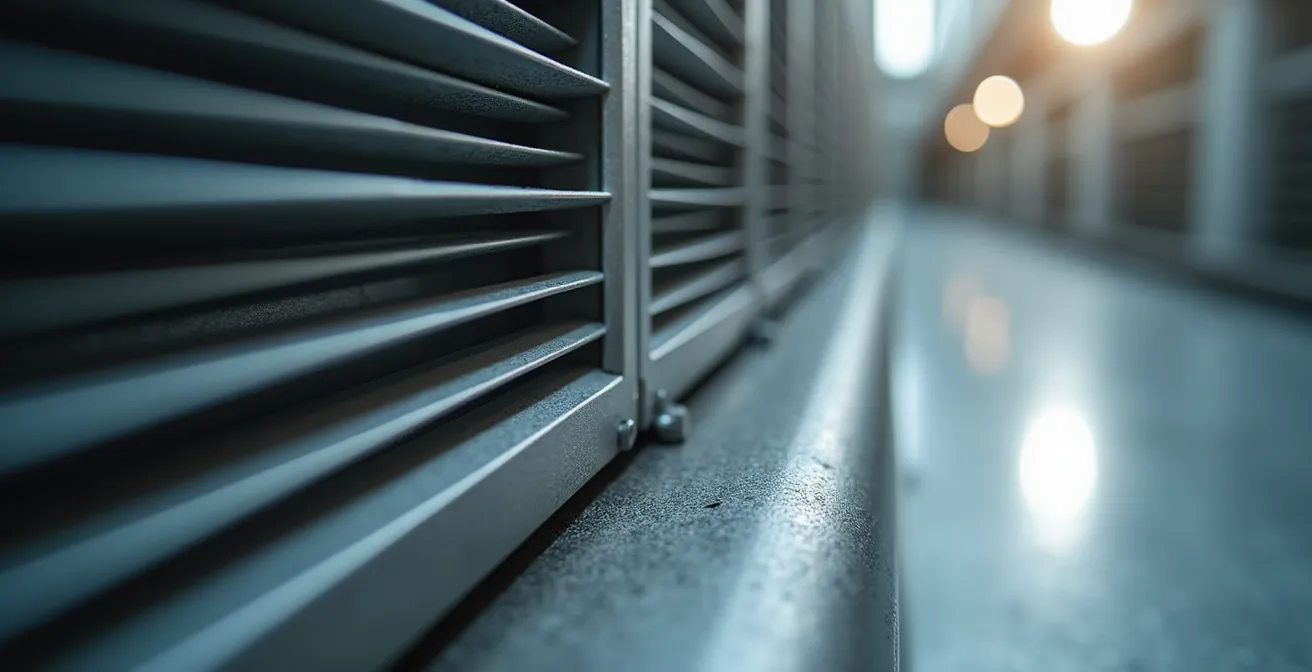
For any construction manager or developer, the end of a project is a race against time and budget. The final line item, “cleanup,” is often seen as a necessary but low-value expense—a final chore before handover. This perspective, however, overlooks a critical financial truth. Post-construction cleanup is not an operational cost; it is a strategic investment that directly protects asset value, mitigates financial risk, and accelerates profitability.
Viewing cleanup through this financial lens transforms it from a simple task into a powerful tool for safeguarding your balance sheet and enhancing your brand. From preserving high-end finishes to ensuring regulatory compliance, a professional approach delivers a return far greater than its initial cost. This is especially true for projects where precision and quality are paramount, such as when engaging services for professional post-construction cleaning in Mississauga to meet exacting client standards.
The Cleanup Investment Blueprint
- Asset Protection: Professional cleaning preserves high-value materials and building systems, preventing long-term depreciation.
- Risk Mitigation: Outsourcing transfers liability, ensures compliance, and avoids costly inspection failures and project delays.
- Cost Efficiency: It eliminates the high opportunity cost of using skilled labor for unskilled tasks and avoids hidden DIY expenses.
- Cash Flow Acceleration: A pristine site leads to faster client sign-off, quicker payments, and enhanced brand reputation.
From Clean Site to Healthy Asset: Securing Long-Term Property Value
The immediate visual appeal of a clean site is obvious, but the real value lies in what you can’t see. Professional cleaning is fundamentally about protecting the building’s core systems and finishes from the microscopic, yet highly corrosive, dust and debris generated during construction. This fine particulate matter can infiltrate every corner of a new build, posing a long-term threat to the asset’s operational health and value.
One of the most vulnerable areas is the HVAC system. When fine dust settles in ductwork, on coils, and in filters, it forces the entire system to work harder to maintain temperature and air quality. Over time, this leads to premature wear and tear on expensive components and, as industry analysis shows, dust-clogged HVAC systems can significantly increase utility bills for the property owner. Professional cleaning is the first line of defense in ensuring a building operates at peak efficiency from day one.
Why is post-construction dust so bad for HVAC systems?
Fine dust and debris clog filters, coat sensitive coils, and restrict airflow. This forces the system to work harder, leading to higher energy consumption, increased maintenance needs, and a shorter operational lifespan for the equipment.
This same principle of preservation applies to the high-value finishes that define a project’s quality. Custom glass, natural stone countertops, and hardwood floors are significant investments that can be permanently damaged by improper cleaning techniques. Amateur crews often use abrasive tools or incorrect chemical agents, causing scratches, chemical burns, and degradation of protective sealants.

Professional cleaners, by contrast, use specific methods and pH-neutral solutions designed to protect these sensitive surfaces, directly preserving the asset’s market value and preventing costly repairs or replacements down the line.
Case Study: The Impact of pH-Neutral Cleaners on High-Value Flooring
An analysis of flooring maintenance shows that using pH-neutral cleaners is critical for asset preservation. Harsh alkaline or acidic chemicals strip away protective finishes on materials like hardwood and natural stone, leading to discoloration, increased susceptibility to scratches, and surface degradation. pH-neutral formulas, however, clean effectively without damaging these sensitive surfaces, maintaining their aesthetic appeal and long-term value, thus protecting the owner’s initial investment.
The following table illustrates how different cleaning approaches directly impact the long-term financial health of a property asset.
| Cleaning Method | Initial Cost | Long-term Impact | Asset Preservation |
|---|---|---|---|
| Professional pH-neutral | Higher | Preserves finishes | Maintains value |
| DIY harsh chemicals | Lower | Damages surfaces | Depreciates value |
| No cleaning | None | Accumulates damage | Significant depreciation |
De-Risking Your Balance Sheet: Cleanup as a Financial and Legal Shield
Beyond protecting physical assets, professional post-construction cleaning serves as a powerful financial and legal shield. The decision to outsource this final step is a strategic move to transfer liability. Professional cleaning companies are bonded and carry their own general liability and workers’ compensation insurance. As cleaning industry insiders suggest, this insulates the general contractor from potential claims related to accidents or damages that occur during the cleaning phase, providing significant peace of mind.
Furthermore, a professionally cleaned site is crucial for passing final inspections. A failure due to cleanliness issues can trigger a cascade of expensive consequences, from contractual penalties for delayed handover to the logistical nightmare of rescheduling subcontractors. These delays directly impact the project’s bottom line. In an industry where a staggering $50 billion was invested in construction technology between 2020 and 2022 to improve efficiency and reduce risk, overlooking the financial impact of a failed cleaning inspection is a critical error.
For specialized projects, such as healthcare facilities, laboratories, or LEED-certified buildings, professional cleaning is not just recommended—it’s a mandatory step for compliance. These environments have stringent standards for air quality and sterility that can only be met with specialized equipment and protocols. Failing to meet these standards can result in hefty financial penalties, loss of certification, or even legal action, making professional cleanup a non-negotiable cost to de-risk the project.
Checklist for Risk Mitigation Through Professional Cleaning
- Verify the cleaning company carries comprehensive general liability and workers’ compensation insurance.
- Ensure their team is trained on OSHA waste disposal guidelines to avoid costly site violations.
- Document the proper handling and disposal of any hazardous materials according to regulations.
- Obtain a formal certification of completion to use as proof for regulatory and compliance requirements.
Calculating the True Expense: The Opportunity Cost of In-House Cleaning
Many contractors believe they save money by assigning cleanup duties to their own laborers. This calculation, however, ignores the most significant expense: opportunity cost. When a skilled tradesperson earning a premium hourly wage is tasked with sweeping floors or wiping down windows, the real cost is the high-value work they are *not* performing. This misallocation of talent slows down project completion and delays the start of the next revenue-generating job, eroding the typical ROI of 20% for well-managed projects.
What is the true cost of DIY construction cleaning?
The true cost isn’t just the laborer’s wage. It includes the high opportunity cost of skilled workers doing unskilled tasks, hidden expenses for specialized equipment, and the financial impact of inefficiency, rework, and potential project delays.
A true cost-benefit analysis reveals the financial fallacy of in-house cleaning. A professional service arrives with a trained, efficient team and all necessary specialized equipment, completing the job in a fraction of the time. This allows your skilled teams to focus on their core competencies, leading to a more streamlined and efficient post-project cleanup overall.
| Factor | In-House Cleaning | Professional Service |
|---|---|---|
| Labor Cost | $25-35/hour (skilled trade) | Included in service |
| Equipment Investment | $5,000-10,000 | None required |
| Time to Complete | 3-5 days | 1-2 days |
| Opportunity Cost | High (delays next project) | Low (parallel work) |
Furthermore, the “do-it-yourself” approach carries significant hidden expenses. The specialized tools required for a true deep clean are not standard construction site equipment.
Analysis of Hidden Costs in DIY Construction Cleaning
A proper construction cleanup requires a significant capital outlay for specialized equipment that most contractors don’t own. This includes industrial-grade HEPA air scrubbers to remove fine particulates, high-powered vacuums, a diverse array of specific cleaning agents for different surfaces, and appropriate personal protective equipment (PPE). These hidden costs can run into thousands of dollars, negating any perceived savings from using in-house labor.
Inefficiency is another major factor. An inexperienced crew not only takes longer but is also more likely to miss critical areas, leading to client complaints, callbacks, and rework—all of which directly diminish the project’s final profitability and damage the contractor’s reputation for quality.
An amateur crew takes longer and often misses critical areas, leading to client callbacks and rework, directly impacting the project’s profitability.
– Construction Business Expert, SKYNOVA Business Guide
Key Takeaways
- Professional cleaning is an investment in asset value, not just an aesthetic touch-up.
- Outsourcing cleanup transfers legal and financial liability away from the general contractor.
- The opportunity cost of using skilled labor for cleaning far outweighs the cost of a professional service.
- A pristine handover accelerates client sign-off, improves cash flow, and builds brand equity.
Accelerating the Final Mile: From Project Handover to Positive Cash Flow
The final phase of a construction project is where profitability is ultimately realized. A flawless presentation is directly linked to business velocity. When a client walks into a pristine, move-in-ready property, the sign-off process is accelerated, final payments are released immediately, and retainage is returned sooner. This direct improvement to the cash flow cycle is invaluable, especially in an industry looking to leverage strategies that promise 15-25% faster project completion through optimized models.
This final presentation is about more than just satisfying the client; it’s about building brand equity. The handover is your last, and most memorable, interaction. A spectacular, dust-free finish creates a premium experience that solidifies your reputation for quality and attention to detail.
| Aspect | Impact | Business Benefit |
|---|---|---|
| Client Sign-off | 2-3 days faster | Immediate final payment |
| Retainage Release | Expedited | Improved cash flow |
| Portfolio Photos | Professional quality | Marketing assets |
| Client Satisfaction | Premium perception | Referrals & testimonials |
The visual evidence of a perfectly executed project becomes a powerful marketing asset. High-quality portfolio photos taken in a clean, finished space are far more compelling than images from a dusty, cluttered site. This attention to detail at the very end is what generates enthusiastic testimonials and powerful word-of-mouth referrals.

As experts in project delivery note, the final impression is what solidifies a project’s success and fuels future business growth. It transforms a simple transaction into a lasting brand statement.
A spectacular handover creates an experience that generates powerful testimonials and compelling portfolio photos.
– Scott Riso, Procore Construction ROI Guide
Finally, consider the psychological impact on the end-user—the buyer or tenant. A property that is immaculate upon handover feels “premium” and “turn-key.” This perception justifies the price tag, reduces friction during final negotiations, and reinforces the value of your work. By investing in a professional finish, you not only close out the current project successfully but also lay the groundwork to optimize business performance on all future endeavors.
Frequently Asked Questions on Construction Cleanup
What insurance should post-construction cleaning companies carry?
Professional cleaners should have general liability and workers’ compensation insurance. This is crucial as it insulates contractors from financial and legal claims related to any accidents or property damage that might occur during the cleaning phase.
How does professional cleaning prevent inspection failures?
Sites that fail final inspections due to cleanliness issues can cause a chain reaction of expensive delays, crew scheduling impacts, and even contractual penalties. Professional cleaning ensures the site meets the required standards for handover, preventing these costly setbacks.
What is the ‘opportunity cost’ of using my own crew for cleanup?
Opportunity cost is the value of the work your skilled laborers are not doing while they are cleaning. Paying a skilled tradesperson to perform an unskilled task like cleaning is inefficient and slows down the project, delaying the start of your next revenue-generating job.